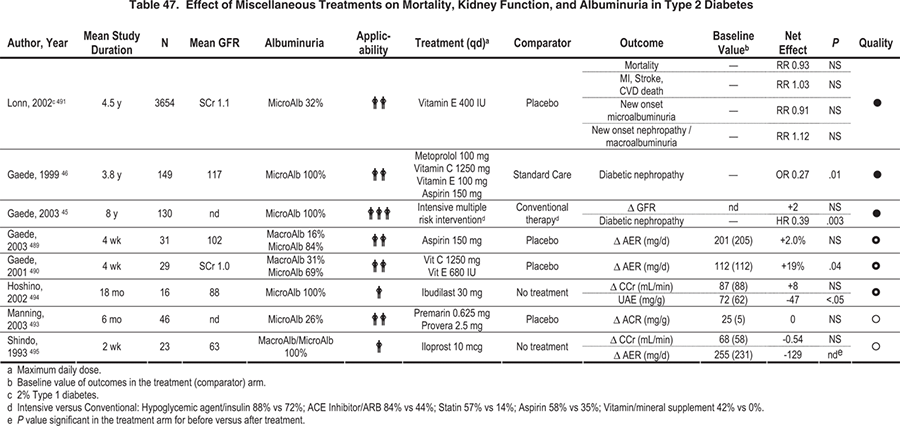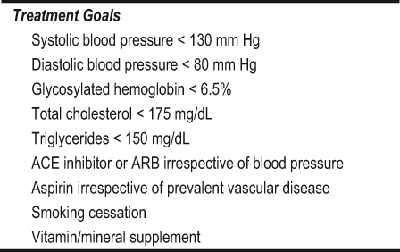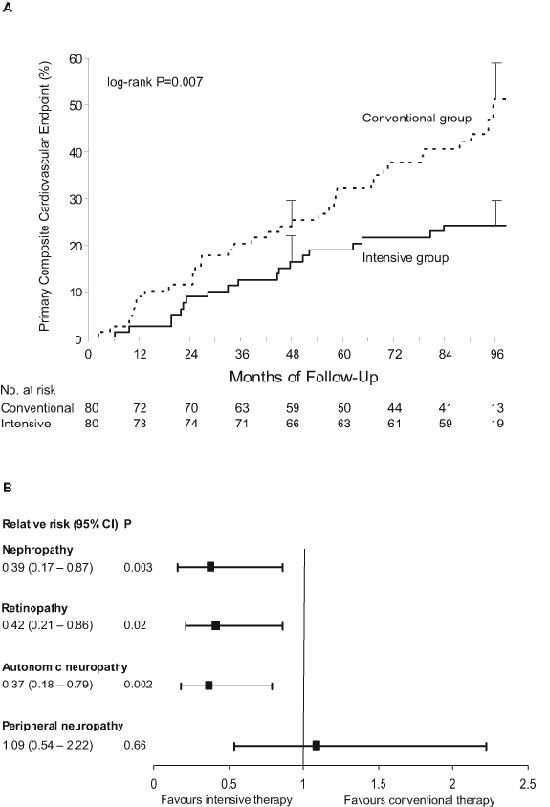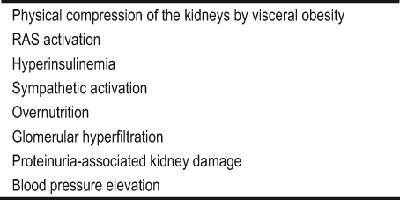
Multiple risk factors are managed concurrently in patients with diabetes and CKD, and the incremental effects of treating each of these risk factors appear to add up to substantial clinical benefits.
2.1 The care of people with diabetes and CKD should incorporate a multifaceted approach to intervention that includes instruction in healthy behaviors and treatments to reduce risk factors. (C)
2.2 Target BMI for people with diabetes and CKD should be within the normal range (18.5-24.9 kg/m2). (C)
This CPR provides a summary of current evidence for a multifaceted approach to intervention in the management of diabetes and CKD. Studies evaluating multifaceted interventions and various other approaches to reducing albuminuria or improving clinical outcomes were reviewed (Table 47).
The care of people with diabetes and CKD should incorporate a multifaceted approach to intervention. (Moderate/Weak)
The Steno Study was a randomized trial that investigated a multifaceted treatment approach (intensive intervention) versus usual care in people with type 2 diabetes and microalbuminuria. The intensive intervention had multiple targets, including behavioral modification and pharmacological therapies for hyperglycemia, hypertension (emphasizing RAS inhibitors), dyslipidemia, CVD prevention with aspirin, and vitamin/mineral supplementation (Table 48). Compared with usual care, patients receiving the intensive intervention had significantly larger mean decreases in systolic blood pressure (11 mm Hg), diastolic blood pressure (4 mm Hg), fasting plasma glucose (34 mg/dL), glycosylated hemoglobin (0.7%), triglycerides (50 mg/dL), total cholesterol (47 mg/dL), and LDL-C (34 mg/dL). These changes corresponded to a mean reduction of albuminuria (albumin reduced 20 mg/24 h) for the intensive intervention, whereas there was a mean increase in patients receiving usual care (albumin increased 30 mg/24 h). The intensive intervention reduced albuminuria progression, retinopathy, neuropathy, and a composite outcome of CVD events or death (Fig 26). 45,46 Other interventions using some of the individual components, such as aspirin or vitamins C or E, did not reduce albuminuria in smaller short-term studies.489,490 Furthermore, vitamin E did not prevent the development or progression of albuminuria or reduce CVD or mortality in a large long-term study of people with type 2 diabetes.491
As key components of multifaceted intervention, clinicians should encourage people with diabetes and CKD to adopt healthy lifestyles that include improved nutrition, exercise, and smoking cessation. Although not clearly associated with better kidney outcomes (such as doubling of serum creatinine or CKD stage 5), control of hyperglycemia, blood pressure, and lipids improve other relevant health outcomes in people with diabetes irrespective of the presence of CKD. For example, although glycemic control has not been proven beneficial for kidney outcomes, it reduces risks for retinopathy and neuropathy.134,136,367,492 Additionally, treatment of elevated LDL-C improves cardiovascular outcomes in people with diabetes (except for those with LDL-C concentrations between 120 and 190 mg/dL who initiate statin therapy while on hemodialysis therapy, Guideline 5).100,177
A critical component of the comprehensive care of people with diabetes and CKD is management of diabetes according to current standards (Guideline 2). Targets for glycemic control should be achieved with a combination of lifestyle approaches, behavioral self-management, and medicines (Guidelines 2 and 5, CPR 4). Particular attention should be given to appropriate screening for common comorbidities and referral to specialists, such as those for eye and foot care. Considering the greatly increased CVD risk in people with diabetes and CKD, risk factors should be managed with a goal of minimizing CVD events, as well as reducing progression of kidney disease (Background, Guidelines 2 to 4). Treatments, such as aspirin and ß-blockers, which are known to reduce CVD risk in other high-risk populations, should be strongly considered in those with diabetes and CKD.

Table 48. Summary of Steno Trial Multifaceted Intervention for Diabetes and CKD45, 46

A normal BMI (18.5 to 24.9 kg/m2) may reduce the risk of loss of kidney function and CVD. (Opinion)
Estimates from the NHANES indicate that 31% of the US population is obese (BMI > 30 kg/m2),214 and obesity is a risk factor for diabetes, hypertension, and CVD. There is a growing body of evidence that obesity also is a risk factor for CKD.215-221 Whether that risk is independent of diabetes, hypertension, or other risk factors is not yet clear. Nevertheless, obesity is associated with the development of proteinuria and loss of kidney function. The development of metabolic risk factors, as well as adipocyte-derived factors, in response to obesity may lead to kidney damage, albuminuria, and loss of glomerular filtration rate (GFR). Mechanisms that may play a role in the relationship between obesity and CKD are summarized in Table 49. Maintaining a normal BMI (18.5 to 24.9 kg/m2) reduces various risk factors for CKD and CVD, which may decrease the development or progression of these diseases. Weight loss should be achieved by a balanced reduction in calorie intake, rather than by diets that derive the majority of calories from animal protein (Guideline 5). Weight management should include a plan for regular physical exercise.

Figure 26. Reduction of End Points with Intensive Multifactorial Therapy in the Steno 2 Study.
Kaplan-Meier estimates of (A) the composite end point of death from cardiovascular causes, nonfatal myocardial infarction, coronary artery bypass grafting, percutaneous coronary intervention, nonfatal stroke, amputation, or surgery for peripheral atherosclerotic artery disease in the conventional-therapy group and intensive-therapy group and (B) relative risk (RR) of the development or progression of nephropathy, retinopathy, and autonomic and peripheral neuropathy during the average follow-up of 7.8 years in the intensive-therapy group compared with the conventional-therapy group. P in A was calculated with use of the log-rank test. The bars in A show standard errors. Abbreviation: CI, confidence interval. Reproduced with permission. 45
Table 49. Proposed Mechanisms for Associations Between Obesity and CKD100, 177, 214, 215, 219 ,221, 492

Multifaceted intervention includes components that may not be directly beneficial for kidney-related outcomes. Because RAS inhibitors are a major component of the intensive intervention, importance of the other components is uncertain. The design of the multifaceted intervention makes it difficult to determine which facets are associated with reduced risk. Whether people already treated with RAS inhibitors would benefit from intensive intervention was not addressed.
Generalizability of this intervention to other clinical settings is unknown. Importantly, studies of multifaceted intervention have been performed only in patients with type 2 diabetes with microalbuminuria. Although multifaceted intervention seems likely to benefit people with type 1 diabetes and CKD, or later stages of CKD in type 2 diabetes, this opinion is based solely on extrapolation. Prospective studies are required to determine benefits and risks of multifaceted intervention across stages of CKD in both types 1 and 2 diabetes.
Studies of various treatments with the potential to influence CKD (albuminuria) in the setting of diabetes were reviewed. However, these treatments were either ineffective (hormone therapy with estrogen/progestin in postmenopausal women)493 or the studies were inconclusive (prostaglandin analogues).494, 495 Whether additional types of treatment will provide incremental benefit to the previously described multifaceted intervention is unknown.
The health benefits of maintaining a normal BMI are not defined in people with diabetes and CKD. Optimal targets for BMI and weight loss should be determined.
The Steno intensive intervention study is a model for a multidisciplinary team approach to care of people with diabetes and microalbuminuria. This specialty clinic–based approach is used successfully for other medical conditions (eg, heart failure and human immunodeficiency virus/acquired immune deficiency syndrome [HIV/AIDS] care), but it requires a critical mass of patients and the presence of specially trained health care personnel.
Other types of interventions that have been used for guideline implementation include computer reminders, provider feedback, and provider incentives. Because of the multifaceted components to the care of both diabetes and CKD, the clinical team approach may be the most effective in settings where feasible. These teams typically are established by large health care organizations.
Prevention and treatment of obesity are major public health concerns. Effective, safe, and sustained weight loss interventions are elusive, and the impact on relevant clinical outcomes is unclear. A longitudinal clinical team approach may be an effective strategy for treatment of obesity in the setting of diabetes and CKD.